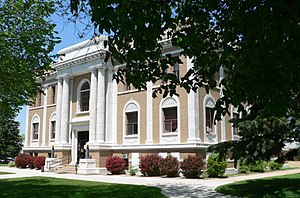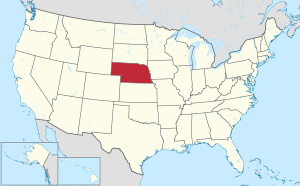Sherman County, Nebraska
Sherman County | |
|---|---|
 Sherman County Courthouse in Loup City | |
 Location within the U.S. state of Nebraska | |
 Nebraska's location within the U.S. | |
| Coordinates: 41°13′N 98°58′W / 41.22°N 98.97°W | |
| Country | |
| State | |
| Founded | 1870 (founded) 1872 (organized) |
| Named for | William Tecumseh Sherman |
| Seat | Loup City |
| Largest city | Loup City |
| Area | |
• Total | 572 sq mi (1,480 km2) |
| • Land | 566 sq mi (1,470 km2) |
| • Water | 5.8 sq mi (15 km2) 1.0% |
| Population (2020) | |
• Total | 2,959 |
| • Density | 5.2/sq mi (2.0/km2) |
| Time zone | UTC−6 (Central) |
| • Summer (DST) | UTC−5 (CDT) |
| Congressional district | 3rd |
Sherman County is a county in the U.S. state of Nebraska. As of the 2020 United States Census, the population was 2,959.[1] Its county seat is Loup City.[2] The county was created in 1870, and was organized in 1872.[3][4][5] It was named for American Civil War General William Tecumseh Sherman.[6]
In the Nebraska license plate system, Sherman County is represented by the prefix 56 (it had the fifty-sixth-largest number of vehicles registered in the county when the license plate system was established in 1922).
Geography
The terrain of Sherman County consists of rolling hills, sloping to the southeast. The area is partially dedicated to agriculture, with limited use of center pivot irrigation. The Middle Loup River flows south-southeastward through the eastern central part of the county. The western portions are drained by Clear Creek and Muddy Creek, which merge in the SW part of the county and exit the south boundary line, to discharge into Middle Loup River at a point southeast of the county's SE corner.[7]
The county has a total area of 572 square miles (1,480 km2), of which 566 square miles (1,470 km2) is land and 5.8 square miles (15 km2) (1.0%) is water.[8]
Major highways
Adjacent counties
- Howard County – east
- Buffalo County – south
- Custer County – west
- Valley County – north
- Greeley County – northeast
Protected areas
- Sherman Reservoir State Recreation Area[9]
Demographics
| Census | Pop. | Note | %± |
|---|---|---|---|
| 1880 | 2,061 | — | |
| 1890 | 6,399 | 210.5% | |
| 1900 | 6,550 | 2.4% | |
| 1910 | 8,278 | 26.4% | |
| 1920 | 8,877 | 7.2% | |
| 1930 | 9,122 | 2.8% | |
| 1940 | 7,764 | −14.9% | |
| 1950 | 6,421 | −17.3% | |
| 1960 | 5,382 | −16.2% | |
| 1970 | 4,725 | −12.2% | |
| 1980 | 4,226 | −10.6% | |
| 1990 | 3,718 | −12.0% | |
| 2000 | 3,318 | −10.8% | |
| 2010 | 3,152 | −5.0% | |
| 2020 | 2,959 | −6.1% | |
| U.S. Decennial Census[10] 1790-1960[11] 1900-1990[12] 1990-2000[13] 2010[14] | |||
As of the 2000 United States Census,[15] there were 3,152 people, 1,392 households, and 903 families in the county. The population density was 5.6 people per square mile (2.2 people/km2). There were 1,392 occupied housing units and 1,941 total housing units. The racial makeup of the county was 99% White, 0.1% Black or African American, 0.1% Native American, 0.3% Asian, 0.1% from other races, and 0.4% from two or more races. 1% of the population were Hispanic or Latino of any race.
There were 1,392 households, out of which 27.6% had children under the age of 18 living with them, 59.2% were married couples living together, 5.7% had a female householder with no husband present, and 32.9% were non-families. 30.4% of all households were made up of individuals, and 16.7% had someone living alone who was 65 years of age or older. The average household size was 2.22 and the average family size was 2.78.
The county population contained 22.4% under the age of 18, 54.2% from 18 to 64, and 23.4% 65 years of age or older. The median age was 47.8 years. 50.9% of the population were female and 49.1% were male.
The median income for a household in the county was $39,041, and the median income for a family was $34,821. Males had a median income of $23,065 versus $17,269 for females. The per capita income for the county was $26,416. About 14.1% of the population were below the poverty line.
Sherman County is one of the main Polish-American communities in the state and in the country. As of the census of 2000, Americans of Polish ancestry comprised 29.6% of Sherman County's population.[16]
Communities
Cities
- Loup City (county seat)
Villages
Politics
Sherman County voters tend to vote Republican. In only three national elections since 1948 has the county selected the Democratic Party candidate (as of 2024).
| Year | Republican | Democratic | Third party(ies) | |||
|---|---|---|---|---|---|---|
| No. | % | No. | % | No. | % | |
| 2024 | 1,344 | 79.43% | 328 | 19.39% | 20 | 1.18% |
| 2020 | 1,322 | 77.76% | 343 | 20.18% | 35 | 2.06% |
| 2016 | 1,150 | 73.11% | 340 | 21.61% | 83 | 5.28% |
| 2012 | 927 | 60.59% | 552 | 36.08% | 51 | 3.33% |
| 2008 | 950 | 60.43% | 585 | 37.21% | 37 | 2.35% |
| 2004 | 1,072 | 65.25% | 541 | 32.93% | 30 | 1.83% |
| 2000 | 1,072 | 62.87% | 564 | 33.08% | 69 | 4.05% |
| 1996 | 822 | 49.16% | 567 | 33.91% | 283 | 16.93% |
| 1992 | 736 | 38.74% | 568 | 29.89% | 596 | 31.37% |
| 1988 | 915 | 51.67% | 839 | 47.37% | 17 | 0.96% |
| 1984 | 1,144 | 61.44% | 701 | 37.65% | 17 | 0.91% |
| 1980 | 1,254 | 63.65% | 578 | 29.34% | 138 | 7.01% |
| 1976 | 935 | 44.67% | 1,078 | 51.51% | 80 | 3.82% |
| 1972 | 1,099 | 57.54% | 811 | 42.46% | 0 | 0.00% |
| 1968 | 955 | 48.09% | 851 | 42.85% | 180 | 9.06% |
| 1964 | 762 | 31.83% | 1,632 | 68.17% | 0 | 0.00% |
| 1960 | 1,131 | 44.21% | 1,427 | 55.79% | 0 | 0.00% |
| 1956 | 1,429 | 53.97% | 1,219 | 46.03% | 0 | 0.00% |
| 1952 | 1,784 | 60.47% | 1,166 | 39.53% | 0 | 0.00% |
| 1948 | 1,003 | 38.41% | 1,608 | 61.59% | 0 | 0.00% |
| 1944 | 1,309 | 45.25% | 1,584 | 54.75% | 0 | 0.00% |
| 1940 | 1,494 | 44.18% | 1,888 | 55.82% | 0 | 0.00% |
| 1936 | 1,294 | 32.01% | 2,701 | 66.81% | 48 | 1.19% |
| 1932 | 952 | 25.79% | 2,670 | 72.32% | 70 | 1.90% |
| 1928 | 1,675 | 48.76% | 1,733 | 50.45% | 27 | 0.79% |
| 1924 | 1,182 | 39.88% | 1,048 | 35.36% | 734 | 24.76% |
| 1920 | 1,582 | 60.96% | 848 | 32.68% | 165 | 6.36% |
| 1916 | 706 | 34.81% | 1,208 | 59.57% | 114 | 5.62% |
| 1912 | 455 | 24.45% | 673 | 36.16% | 733 | 39.39% |
| 1908 | 776 | 43.74% | 925 | 52.14% | 73 | 4.11% |
| 1904 | 809 | 56.30% | 140 | 9.74% | 488 | 33.96% |
| 1900 | 503 | 38.63% | 743 | 57.07% | 56 | 4.30% |
See also
References
- ^ "Sherman County, Nebraska". United States Census Bureau. Retrieved June 24, 2023.
- ^ "Find a County". National Association of Counties. Retrieved June 7, 2011.
- ^ Fitzpatrick, Lilian Linder (1925). Nebraska Place-Names. Lincoln: University of Nebraska Studies in Language, Literature, and Criticism. p. 135. Retrieved December 17, 2014.
- ^ Andreas, A. T. (1882). "Andreas' History of the State of Nebraska". The Kansas Collection. Archived from the original on May 10, 2003. Retrieved December 17, 2014.
- ^ "Sherman County". Nebraska Association of County Officials. Retrieved December 17, 2014.
- ^ "Sherman County". Archived from the original on July 4, 2008. Retrieved February 13, 2010.
- ^ Sherman County NE Google Maps (accessed 25 January 2019)
- ^ "2010 Census Gazetteer Files". US Census Bureau. August 22, 2012. Archived from the original on November 13, 2013. Retrieved December 11, 2014.
- ^ Sherman Reservoir SRA Google Maps (accessed 25 January 2019)
- ^ "U.S. Decennial Census". United States Census Bureau. Retrieved December 11, 2014.
- ^ "Historical Census Browser". University of Virginia Library. Retrieved December 11, 2014.
- ^ "Population of Counties by Decennial Census: 1900 to 1990". United States Census Bureau. Retrieved December 11, 2014.
- ^ "Census 2000 PHC-T-4. Ranking Tables for Counties: 1990 and 2000" (PDF). United States Census Bureau. Archived (PDF) from the original on March 27, 2010. Retrieved December 11, 2014.
- ^ "State & County QuickFacts". United States Census Bureau. Retrieved September 22, 2013.
- ^ "U.S. Census website". US Census Bureau. Retrieved January 31, 2008.
- ^ "QT-P13 - Ancestry: 2000". US Census Bureau. Archived from the original on February 12, 2020. Retrieved February 1, 2016.
- ^ Election Results
- ^ The leading "other" candidate, Progressive Theodore Roosevelt, received 592 votes, while Socialist candidate Eugene Debs received 123 votes and Prohibition Eugene Chafin received 18 votes.

